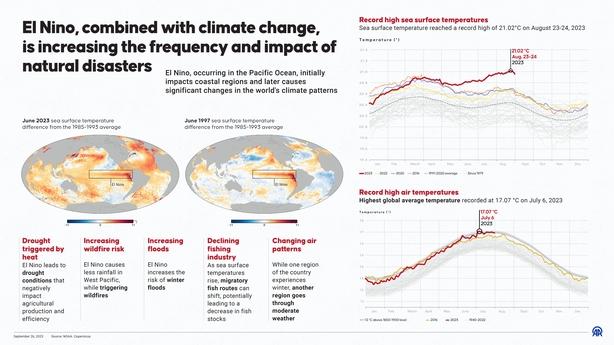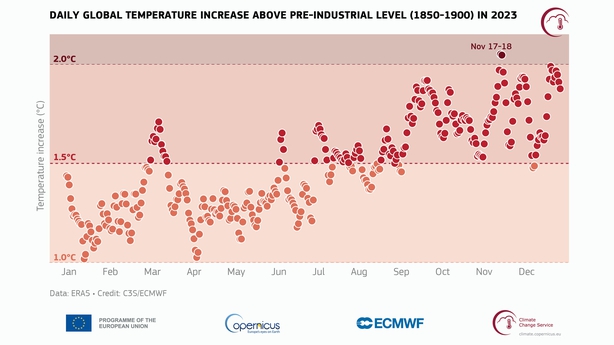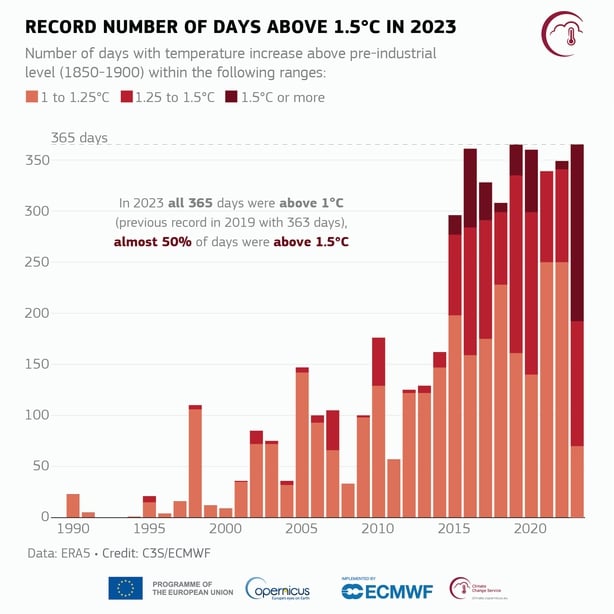2023 hottest year on record as Earth nears critical 1.5C limit, says EU monitor
Updated / Tuesday, 9 Jan 2024 18:35
Global temperatures last year reached exceptionally high levels averaging close to 1.5C above pre-industrial levels, according to new analysis from the EU’s climate change service, Copernicus.
The report highlights several record-breaking conditions, including the hottest month on record and daily global temperature averages briefly surpassing pre-industrial levels by more than 2C.
Last year’s average temperature was 14.98C, which beats the previous hottest year set in 2016 by 0.17C.

The global community committed in the Paris Agreement to try and limit warming to 1.5C above pre-industrial levels as it gives the best chance of stabilising the climate and reducing the damage to people and wildlife.
This measurement is taken as a decadal average, so one year going beyond this does not mean the treaty has failed.
July 2023 was likely the hottest month in the last 120,000 years, almost as long as modern humans have existed, while Antarctic sea ice has been at an historic low.

Each month from June through to December was hotter than any other corresponding month in a previous year, while every continent except Australia and many ocean areas saw record-breaking annual air temperatures for the year.
El Niño, a cyclical natural phenomenon in the tropical eastern Pacific that brings heat to the surface, added an extra warming effect to the atmosphere and oceans to that from greenhouse gas emissions, which continue to rise.

Scientists are urging the global community to radically cut these emissions and prevent further warming as each fraction of a degree further destabilises the Earth’s climate.
Although changes of 1.5C in people’s day-to-day experience of air temperature is negligible, on a global average it has a very different meaning and the smallest changes can have large ramifications.

Some climate analysts have likened it to changes in body temperature whereby a difference of 1C can separate a healthy person from one with a fever.
Copernicus Deputy Director, Dr Samantha Burgess said: “2023 was an exceptional year with climate records tumbling like dominoes.
“Not only is 2023 the warmest year on record, it is also the first year with all days over 1C warmer than the pre-industrial period.
“Temperatures during 2023 likely exceed those of any period in at least the last 100,000 years.”
The end of the El Niño weather pattern in 2024 will see the climate likely get worse before it gets better, according to Dr Burgess.
“The impact of the El Niño is always stronger the second year of the event. So for the start of 2024 we are already seeing record temperatures globally and we’re likely to continue to see record temperatures until for the next two or three months,” she said.
“When we look at the El Niño forecast it looks like the event will peak soon and then it’ll transition to a more neutral state which means it won’t have this warming effect on global temperatures,” she added.
Speaking on RTÉ’s News At One, Dr Burgess said the extra heat in the oceans and extra greenhouse gases in the atmosphere mean scientists will have to monitor their impacts to see how the climate will “evolve” this year.
However, she described the El Niño as little more than “a small factor” behind the rising temperature in 2023 as Copernicus was recording record high sea surface temperatures before the event started.

Emissions from wildfires also increased by 30% last year mainly because of the huge blazes across Canada.
There were marine heatwaves across much of the North Atlantic, including off the British and Irish coastlines, as well as in the Caribbean and the Indian and Pacific Oceans.
Concentrations of carbon dioxide in the atmosphere rose to a new height of 419 parts per million while methane reached a concentration of 1,902 parts per billion.
Additional reporting PA

